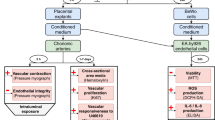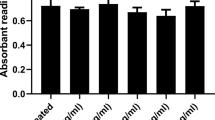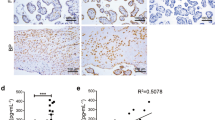Abstract
Preeclampsia is a disorder of pregnancy characterized by endothelial activation. It is believed to be a response to a ‘toxin(s)’ from the placenta including trophoblastic debris and inflammatory cytokines. Calcium is known to reduce the risk of preeclampsia but the mechanism of its protective effect remains unknown. In this study, we investigated the potential mechanism(s) of calcium supplementation for preventing endothelial activation induced by trophoblastic debris. Trophoblastic debris was harvested from preeclamptic placentae and also from first-trimester placentae, which had been treated with preeclamptic sera. Endothelial cells were then cultured with trophoblastic debris in the presence of calcium. Endothelial activation was measured by quantifying endothelial cell-surface intercellular adhesion molecule-1 (ICAM-1) and by U937 monocyte adhesion to endothelial cells. The expression of ICAM-1 and U937 adhesion to endothelial cells were significantly reduced following exposure of endothelial cells to trophoblastic debris from preeclamptic placenta or from first-trimester placentae treated with preeclamptic sera in the presence of calcium compared with treatment without calcium. The expression of ICAM-1 was also significantly reduced following exposure of endothelial cells to trophoblastic debris with the nitric oxide donor or following treatment of endothelial cells with interleukin (IL)-1β in the presence of calcium. Our study demonstrated that calcium supplementation prevented endothelial cell activation induced by trophoblastic debris from preeclamptic placentae. The nitric oxide synthase (NOS) pathway and anti-inflammatory effects are involved in the action of calcium on endothelial cell activation. These findings may suggest, at least in part, the protective mechanism of calcium supplementation on preeclampsia.
This is a preview of subscription content, access via your institution
Access options
Subscribe to this journal
Receive 12 digital issues and online access to articles
$119.00 per year
only $9.92 per issue
Buy this article
- Purchase on Springer Link
- Instant access to full article PDF
Prices may be subject to local taxes which are calculated during checkout




Similar content being viewed by others
References
Sibai B, Dekker G, Kupferminc M, Pre-eclampsia . The Lancet 2005; 365: 785–799.
Schmorl G . Pathologisch-Anatomische Untersuchungen Uber Puerperal-Eklampsie. Vogel: Leipzig, Germany, 1893.
Chua S, Wilkins T, Sargent I, Redman C . Trophoblast deportation in pre-eclamptic pregnancy. Br J Obstet Gynaecol 1991; 98: 973–979.
Huppertz B, Kingdom J, Caniggia I, Desoye G, Black S, Korr H et al. Hypoxia favours necrotic versus apoptotic shedding of placental syncytiotrophoblast into the maternal circulation. Placenta 2003; 24: 181–190.
Levine RJ, Maynard SE, Qian C, Lim KH, England LJ, Yu KF et al. Circulating angiogenic factors and the risk of preeclampsia. N Engl J Med 2004; 350: 672–683.
Levine RJ, Lam C, Qian C, Yu KF, Maynard SE, Sachs BP et al. Soluble endoglin and other circulating antiangiogenic factors in preeclampsia. N Engl J Med 2006; 355: 992–1005.
Rajakumar A, Cerdeira AS, Rana S, Zsengeller Z, Edmunds L, Jeyabalan A et al. Transcriptionally active syncytial aggregates in the maternal circulation may contribute to circulating soluble fms-like tyrosine kinase 1 in preeclampsia. Hypertension 2012; 59: 256–264.
Buurma AJ, Penning ME, Prins F, Schutte JM, Bruijn JA, Wilhelmus S et al. Preeclampsia is associated with the presence of transcriptionally active placental fragments in the maternal lung. Hypertension 2013; 62: 608–613.
Shen F, Wei J, Snowise S, DeSousa J, Stone P, Viall C et al. Trophoblast debris extruded from preeclamptic placentae activates endothelial cells: a mechanism by which the placenta communicates with the maternal endothelium. Placenta 2014; 35: 839–847.
Chamley LW, Chen Q, Ding J, Stone PR, Abumaree M . Trophoblast deportation: just a waste disposal system or antigen sharing? J Reprod Immunol 2011; 88: 99–105.
Duley L, Henderson-Smart DJ, Walker GJ, Chou D . Magnesium sulphate versus diazepam for eclampsia. Cochrane Database Syst Rev 2010, CD000127.
Hofmeyr GJ, Lawrie TA, Atallah AN, Duley L . Calcium supplementation during pregnancy for preventing hypertensive disorders and related problems. Cochrane Database Syst Rev 2010, CD001059.
Duley L, Henderson-Smart DJ, Meher S, King JF . Antiplatelet agents for preventing pre-eclampsia and its complications. Cochrane Database Syst Rev 2007, CD004659.
Chen Q, Tong M, Wu M, Stone PR, Snowise S, Chamley LW . Calcium supplementation prevents endothelial cell activation: possible relevance to preeclampsia. J Hypertens 2013; 31: 1828–1836.
Chen Q, Zhang Y, Tong M, Wu M, Snowise S, Stone P et al. Pre-treatment with calcium prevents endothelial cell activation induced by multiple activators, necrotic trophoblastic debris or IL-6 or preeclamptic sera: possible relevance to the pathogenesis of preeclampsia. Placenta 2013; 34: 1196–1201.
Schroeder BM . ACOG practice bulletin on diagnosing and managing preeclampsia and eclampsia. American College of Obstetricians and Gynecologists. Am Fam Phys 2002; 66: 330–331.
American College of Obstetricians and Gynecologists; Task Force on Hypertension in Pregnancy.. Hypertension in pregnancy. Obstet Gynecol 2013; 122: 1122–1131.
Ades EW, Candal FJ, Swerlick RA, George VG, Summers S, Bosse D C et al. HMEC-1: establishment of an immortalized human microvascular endothelial cell line. J Invest Dermatol 1992; 99: 683–690.
Chen Q, Stone PR, McCowan LM, Chamley LW . Phagocytosis of necrotic but not apoptotic trophoblasts induces endothelial cell activation. Hypertension 2006; 47: 116–121.
Abumaree MH, Stone PR, Chamley LW . An in vitro model of human placental trophoblast deportation/shedding. Mol Hum Reprod 2006; 12: 687–694.
Chen Q, Ding J X, Liu B, Stone P, Feng YJ, Chamley LW . Spreading endothelial cell dysfunction in response to necrotic trophoblasts. soluble factors released from endothelial cells that have phagocytosed necrotic shed trophoblasts reduce the proliferation of additional endothelial cells. Placenta 2010; 31: 75–80.
Chen Q, Stone P, Ching LM, Chamley L . A role for interleukin-6 in spreading endothelial cell activation after phagocytosis of necrotic trophoblastic material: implications for the pathogenesis of pre-eclampsia. J Pathol 2009; 217: 122–130.
Edwards SL . Maintaining calcium balance: physiology and implications. Nurs Times 2005; 101: 58–61.
Attwood HD, Park WW . Embolism to the lungs by trophoblast. J Obstet Gynaecol Br Commonw 1961; 68: 611–617.
Chen Q, Chen L, Liu B, Viall C, Stone P, Ching LM et al. The role of autocrine TGFbeta1 in endothelial cell activation induced by phagocytosis of necrotic trophoblasts: a possible role in the pathogenesis of pre-eclampsia. J Pathol 2010; 221: 87–95.
Callaway LK, O'Callaghan M, McIntyre HD . Obesity and the hypertensive disorders of pregnancy. Hypertens Pregnancy 2009; 28: 473–493.
Chen Q, Guo F, Hensby-Bennett S, Stone P, Chamley L . Antiphospholipid antibodies prolong the activation of endothelial cells induced by necrotic trophoblastic debris: implications for the pathogenesis of preeclampsia. Placenta 2012; 33: 810–815.
Chen Q, Guo F, Liu S, Xiao J, Wang C, Snowise S et al. Calcium channel blockers prevent endothelial cell activation in response to necrotic trophoblast debris: possible relevance to pre-eclampsia. Cardiovasc Res 2012; 96: 484–493.
Chen Q, Guo F, Jin HY, Lau S, Stone P, Chamley L . Phagocytosis of apoptotic trophoblastic debris protects endothelial cells against activation. Placenta 2012; 33: 548–553.
Ganz P, Vita JA . Testing endothelial vasomotor function: nitric oxide, a multipotent molecule. Circulation 2003; 108: 2049–2053.
Vita JA . Endothelial function. Circulation 2011; 124: e906–e912.
Treasure CB, Klein JL, Vita JA, Manoukian SV, Renwick GH, Selwyn AP et al. Hypertension and left ventricular hypertrophy are associated with impaired endothelium-mediated relaxation in human coronary resistance vessels. Circulation 1993; 87: 86–93.
Lopez-Jaramillo P, Gonzalez MC, Palmer RM, Moncada S . The crucial role of physiological Ca2+ concentrations in the production of endothelial nitric oxide and the control of vascular tone. Br J Pharmacol 1990; 101: 489–493.
Amash A, Holcberg G, Sapir O, Huleihel M . Placental secretion of interleukin-1 and interleukin-1 receptor antagonist in preeclampsia: effect of magnesium sulfate. J Interferon Cytokine Res 2012; 32: 432–441.
Acknowledgements
This study was supported by grants from Istar, a not-for-profit company registered in New Zealand, and the Auckland Medical Research Foundation (AMRF). We thank all the staff at the Epsom Day Unit, Auckland City Hospital and Auckland Medical Aid Centre for their help in collecting samples for this study. We also thank the women who donated blood and tissue for this study.
Author information
Authors and Affiliations
Corresponding author
Ethics declarations
Competing interests
The authors declare no conflict of interest.
Rights and permissions
About this article
Cite this article
DeSousa, J., Tong, M., Wei, J. et al. The anti-inflammatory effect of calcium for preventing endothelial cell activation in preeclampsia. J Hum Hypertens 30, 303–308 (2016). https://doi.org/10.1038/jhh.2015.73
Received:
Revised:
Accepted:
Published:
Issue Date:
DOI: https://doi.org/10.1038/jhh.2015.73
This article is cited by
-
Micronutrient supplementation interventions in preconception and pregnant women at increased risk of developing pre-eclampsia: a systematic review and meta-analysis
European Journal of Clinical Nutrition (2023)



